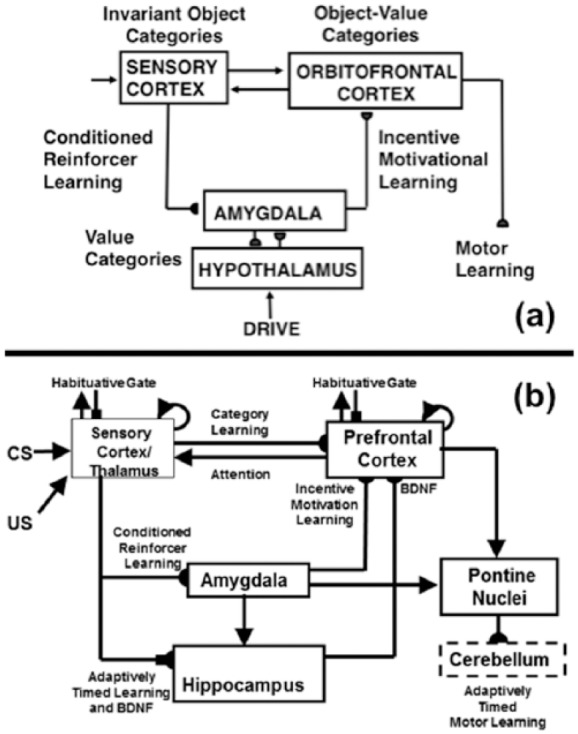Figure 2.

(a) CogEM (Cognitive-Emotional-Motor) neural model circuits and their anatomical interpretation. CogEM models how invariant object categories in sensory cortex can activate value categories, also called drive representations, in the amygdala and hypothalamus, and object-value categories in the orbitofrontal cortex. Converging output signals from an object category and its value category are needed to vigorously fire the corresponding object-value category. Achieving such convergence from the amygdala requires prior conditioned reinforcer learning and incentive motivational learning. Activation of a value category also requires converging signals: from its object category and its internal drive input. When an object-value category fires, it can send positive feedback to its object category and attentionally enhance it with value-modulated activation. The motivationally enhanced object category can then better compete with other object categories via a recurrent competitive network (not shown) and draw attention to itself. Closing the feedback loop between object, value, and object-value categories causes a cognitive-emotional resonance that can induce a conscious percept of having a particular emotion, or feeling, towards the attended object, as well as knowing what it is. As this resonance develops, the object-value category can generate output signals that can activate cognitive expectations and action commands through other brain circuits. Adapted with permission from Grossberg and Seidman (2006). (b) The neurotrophic Spectrally Timed Adaptive Resonance Theory, or nSTART, model macrocircuit is a further development of the START model in which parallel and interconnected networks support both delay and trace conditioning. Connectivity from both the thalamus and the sensory cortex occurs to the amygdala and hippocampus. Sensory cortex interacts reciprocally with prefrontal cortex, specifically orbitofrontal cortex. Multiple types of learning and neurotrophic mechanisms of memory consolidation cooperate in these circuits to generate adaptively timed responses. Connections from the sensory cortex to the orbitofrontal cortex support category learning. Reciprocal connections from orbitofrontal cortex to sensory cortex support motivated attention. Habituative transmitter gates modulate excitatory conductances at all processing stages. Connections from sensory cortex to amygdala support conditioned reinforcer learning. Connections from amygdala to orbitofrontal cortex support incentive motivation learning. Hippocampal adaptively timed learning and brain-derived neurotrophic factor (BDNF) bridge temporal delays between CS offset and US onset during trace conditioning acquisition. BDNF also supports long-term memory consolidation within sensory cortex to hippocampal pathways and from hippocampal to orbitofrontal pathways. The pontine nuclei serve as a final common pathway for reading-out conditioned responses. Cerebellar dynamics are not simulated in nSTART. Arrowhead: excitatory synapse; hemidisc: adaptive weight; square: habituative transmitter gate; square followed by a hemidisc: habituative transmitter gate followed by an adaptive weight. Reprinted with permission from Franklin and Grossberg (2017).
